
Real-Time Customer Feedback in SaaS: Importance and Best Practices
Imagine having a direct line to your customers' thoughts and experiences as they navigate your product; that's the power of real-time customer feedback in the SaaS world. This dynamic approach to understanding your users isn't just about collecting feedback—it's an open channel for instant insights, which allows you to make quicker informed decisions that redefine the user experience.
Whether through in-app feedback widgets or live chats, your capacity to immediately respond to and implement customer suggestions can propel your product development forward, ensuring a continuously evolving service that remains a step ahead in meeting your audience's ever-changing desires. And in the competitive SaaS landscape, staying attuned to your customers in real time isn't just advantageous—it's essential for growth and retention.
What is Real-Time Feedback?
Imagine you've just launched a new feature in your SaaS product. How do you instantly know what your users think? That's where real-time customer feedback jumps in! This quick-response system lets you capture customer feedback as they interact with your product. It's like having a conversation where customers tell you what's hot and what's not right on the spot!
So, why get excited about real-time feedback? It’s all about the immediacy. You can gauge customer sentiment, gather opinions, and monitor behavior exactly when the experience is fresh in their minds. Think about it: you get a direct line to their first impressions. Feedback widgets, in-app surveys, and live chat are popular methods to make this magic happen.
Let’s dive into the different types of feedback you might get. There's CSAT (Customer Satisfaction Score), where customers rate their satisfaction. Or Net Promoter Score (NPS), which gauges the likelihood that they’ll recommend your product. And let's not forget the Customer Effort Score (CES), which measures how easy it was for them to use your product or service.
And here’s the best part: all this feedback creates a loop – the feedback loop – that empowers you to iterate and improve continuously. You're always in tune with your users, making better informed and timely decisions. So make the most of real-time feedback, and watch your SaaS soar with instant user insights.
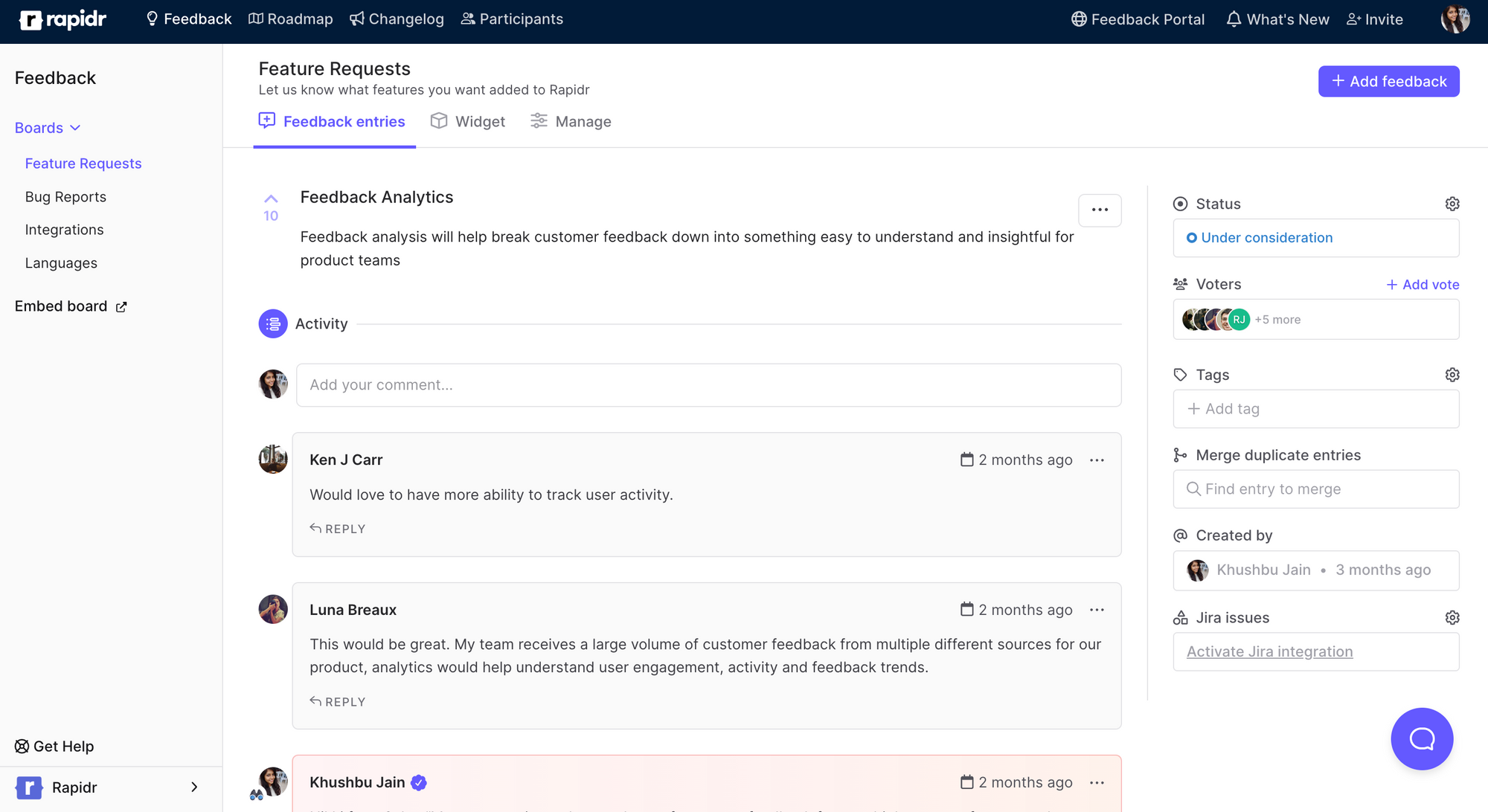
Different Types of Real-Time Feedback
Real-time customer feedback has revolutionized how SaaS companies understand and engage with their users.
- Live Chat Feedback: Interact directly with your users through live chat. Get their thoughts while using your product, revealing immediate reactions and feelings about your SaaS.
- In-App Surveys: Pop-up surveys appear within your app, prompting users to give their opinion on a new feature or the overall user experience. The key is timing – ask the right question at the right moment.
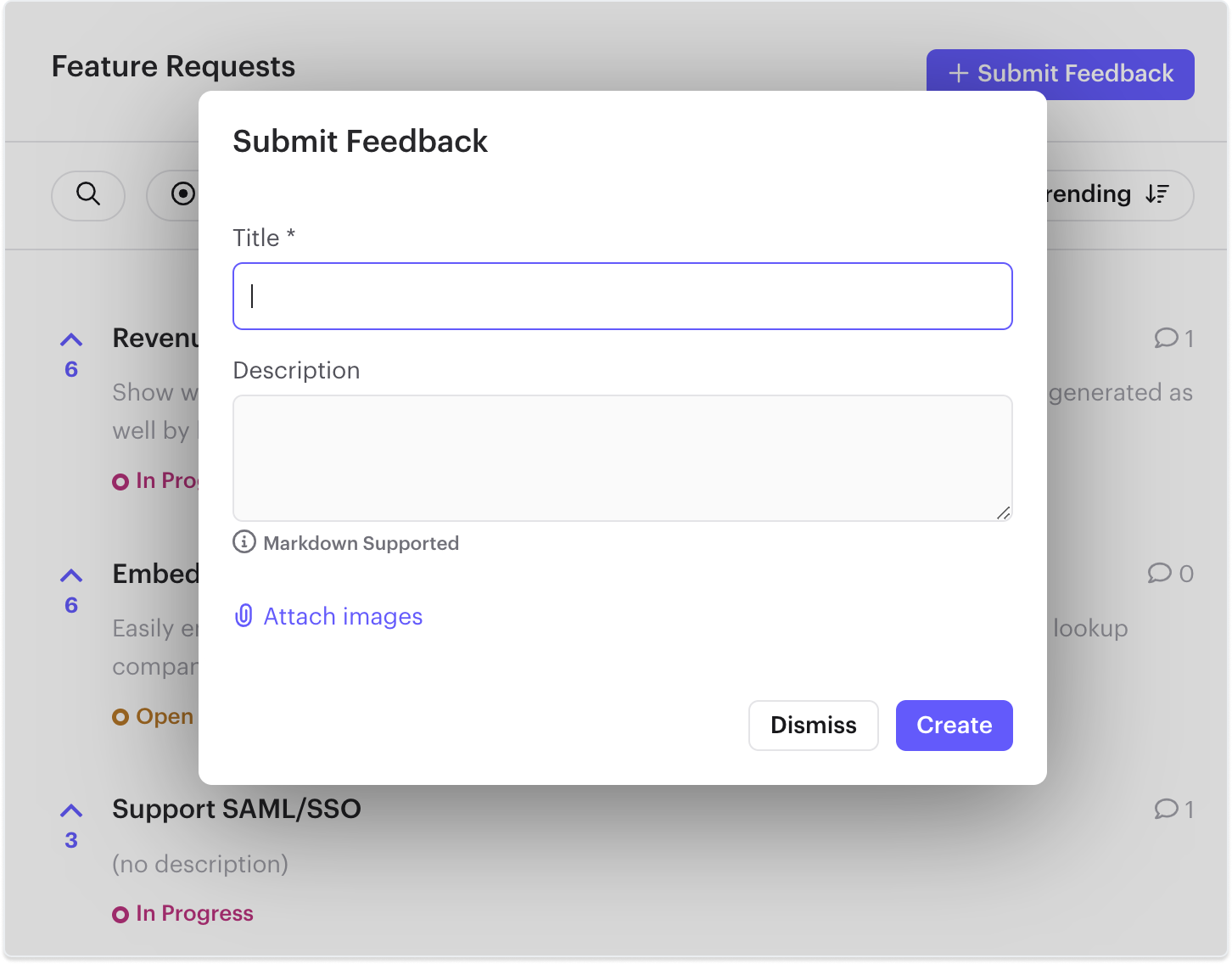
- User Behavior Analytics: Use tools to track user interactions in your application. Understand which features are loved and which ones may be causing frustration without intruding on the user experience.
- Usability Tests: Involve users in interactive tasks on your platform. Observe how they navigate and use the interface to gain insights into where they encounter smooth sailing or choppy waters to collect beta testing feedback.
- Social Media Sentiment Analysis: Social platforms are where many users voice real-time opinions. Analyzing social media sentiment lets you instantly capture the mood surrounding your product.
What are the benefits of real-time customer feedback?
Imagine enhancing your product in the blink of an eye. That's the magic of real-time customer feedback in the SaaS world! This rapid input from users lets you pivot quickly, ensuring your service always aligns with customer needs. Here’s how you stand to gain:
- Instant Gratification: Your customers feel heard immediately. This strengthens customer trust, signaling that their opinions aren't just collected. They're valued and impactful.
- Spot-on Improvements: You can make relevant changes when receiving real-time feedback. This means your product evolves side-by-side with customer expectations, staying on the cutting edge.
- Lightning-Fast Issue Resolution: Say goodbye to the days of slow customer service. With real-time feedback, you quickly identify and fix issues, sometimes even before they snowball. This is customer service at its finest.
- Data-Driven Decisions: Every piece of feedback is a goldmine of data. It guides your decisions precisely, ensuring that each step is backed by solid customer insight.
- Training Opportunities: Unfiltered, immediate feedback becomes a powerful training tool for your team, helping them understand and adapt to real-time customer needs.
When to Ask for Real-Time Customer Feedback?
Knowing when to seek this invaluable input can significantly enhance your product development and ensure your UI is powerful and pleasurable. Let's explore the strategic moments for collecting user feedback:
- Immediately After Onboarding: Capture the enthusiasm of new users and understand their first impressions of your UI. Their feedback can pinpoint initial pain points in the user experience.
- During the Customer Journey: Key touchpoints provide timely opportunities. Use a dashboard notification or a subtle prompt when interacting with new features. With Rapidr, you can capture in-app feedback by embedding a feedback board directly into your app. The more you collect and act on feedback, the more likely you’ll increase product adoption.
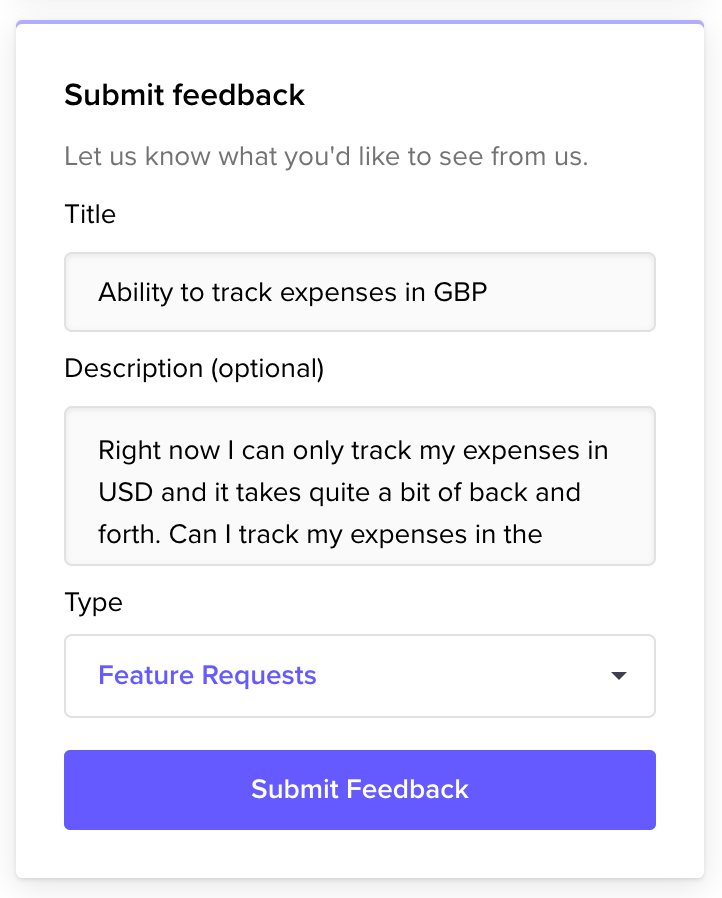
- After Releasing Updates: When you roll out changes or new features based on your roadmap, see how they resonate. It's a golden chance to evaluate if you've addressed previous concerns effectively. It's also good practice to communicate back to your customers to let them know that their feedback is valued and has been heard.

- When Users Encounter Errors: If a user experiences an error, support and customer success teams offer a way to voice their troubles immediately. It's a proactive step in showing commitment to resolving issues swiftly.
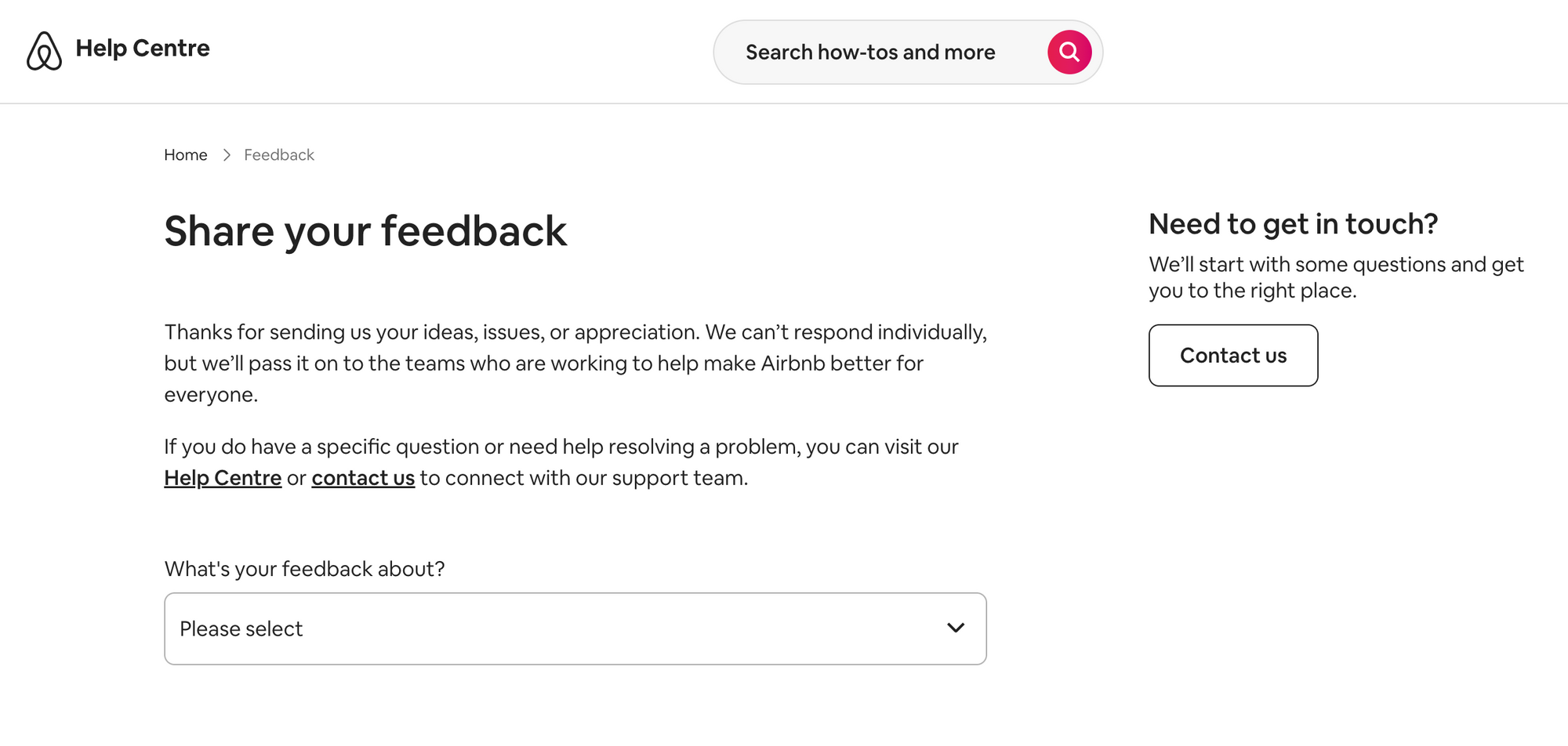
- Before Big Decisions: Tap into user sentiment before finalizing your product roadmap decisions. It verifies that your development aligns with customer pain points.
How to Collect Real-time User Feedback?
Gathering user feedback in real-time offers immediate insights into your SaaS product's user experience, letting you make quick and informed decisions for product improvement. The following methods can equip you with the tools to capitalize on feedback while it's fresh and most valuable.
1. Effective In-app Surveys
Incorporate in-app customer satisfaction surveys such as NPS, CES, or CSAT surveys with feedback questions about your product. Surveys with high response rates often contain short, specific multiple-choice and open-ended customer feedback questions that appear seamlessly during user interaction. Their non-intrusive nature means you gain valuable insights without disrupting the user experience.
Spark innovation by asking users to rate features within the app. Your customer journey becomes a gold mine for insights, showing you which features excite and which are pain points. Tools like SurveyMonkey, Google Forms, or Typeform can help you create and distribute in-app feedback surveys.

2. Feedback Widgets
Feedback Widgets are an unobtrusive yet omnipresent way to collect thoughts and opinions as users navigate your SaaS product. Easily accessible widgets encourage users to leave spontaneous feedback without disrupting their experience. Customer feedback tools like Rapidr allow easy widget integration, allowing users to provide feedback whenever inspiration strikes.
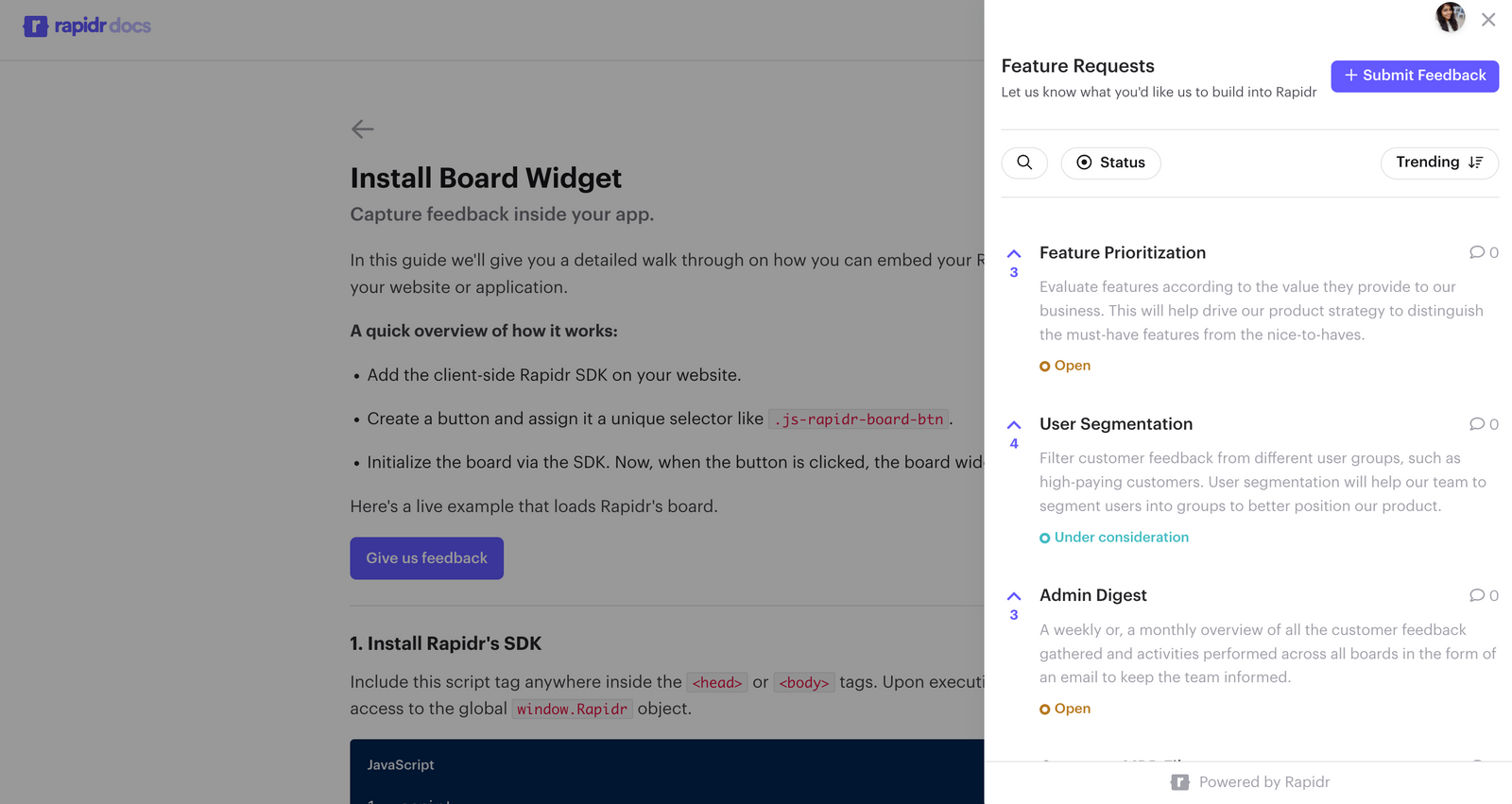
3. In-app Feedback
In-app Feedback tools can be implemented to prompt users to give specific feedback on features they use. These tools can provide direct insights into what's working well and what needs attention while the experience is fresh in the user's mind. Immediate feedback lets you prioritize product improvements based on real user pain points in your development cycle.
Utilize in-app feedback platforms to ask users about their experiences in real time. This can be done through chatbots or pop-up messages, prompting immediate feedback while the user is engaged with the product.
4. Live Chat
A Live Chat feature is a direct communication channel where users can report issues or offer praise in real time. Get instant feedback while users are engaged.
Monitor real-time sentiments to see how changes to the UI are received. This immediacy can boost satisfaction by showing users that their feedback is valued and potentially acted upon quickly. Train your team to recognize and escalate valuable feedback for analysis and action. Rapidr's deep Intercom Integration makes it easy for your product and customer success teams to track incoming feedback on Intercom.

5. Community Feedback Forums
Create a space where users can discuss their experiences and provide feedback. This could be a dedicated community forum or a discussion board within your website. A centralized place for product feedback to keep track of different types of customer feedback and improve SaaS products while listening to their customers.
Rapidr helps SaaS companies be more customer-centric by consolidating feedback across different apps, prioritizing requests, having a discourse with customers, and closing the feedback loop.
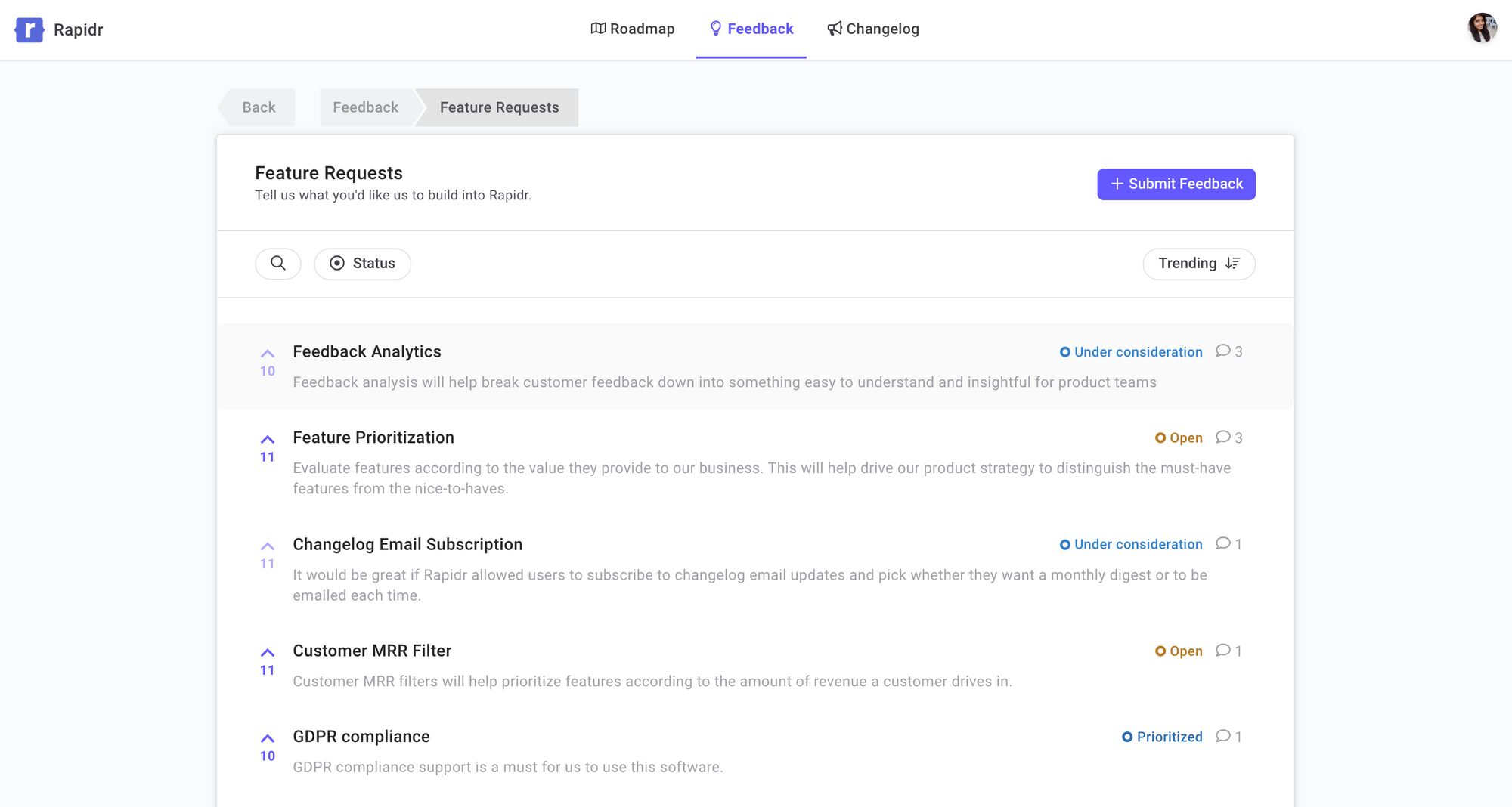
6. Customer Support Tickets
Analyze interactions with customer support, including phone calls, emails, and tickets. Real-time feedback can be gathered by asking for a satisfaction rating immediately after a support interaction. Ensure an internal team feedback system is set up so that this valuable information can be collected from customer-facing teams and shared with the product team.
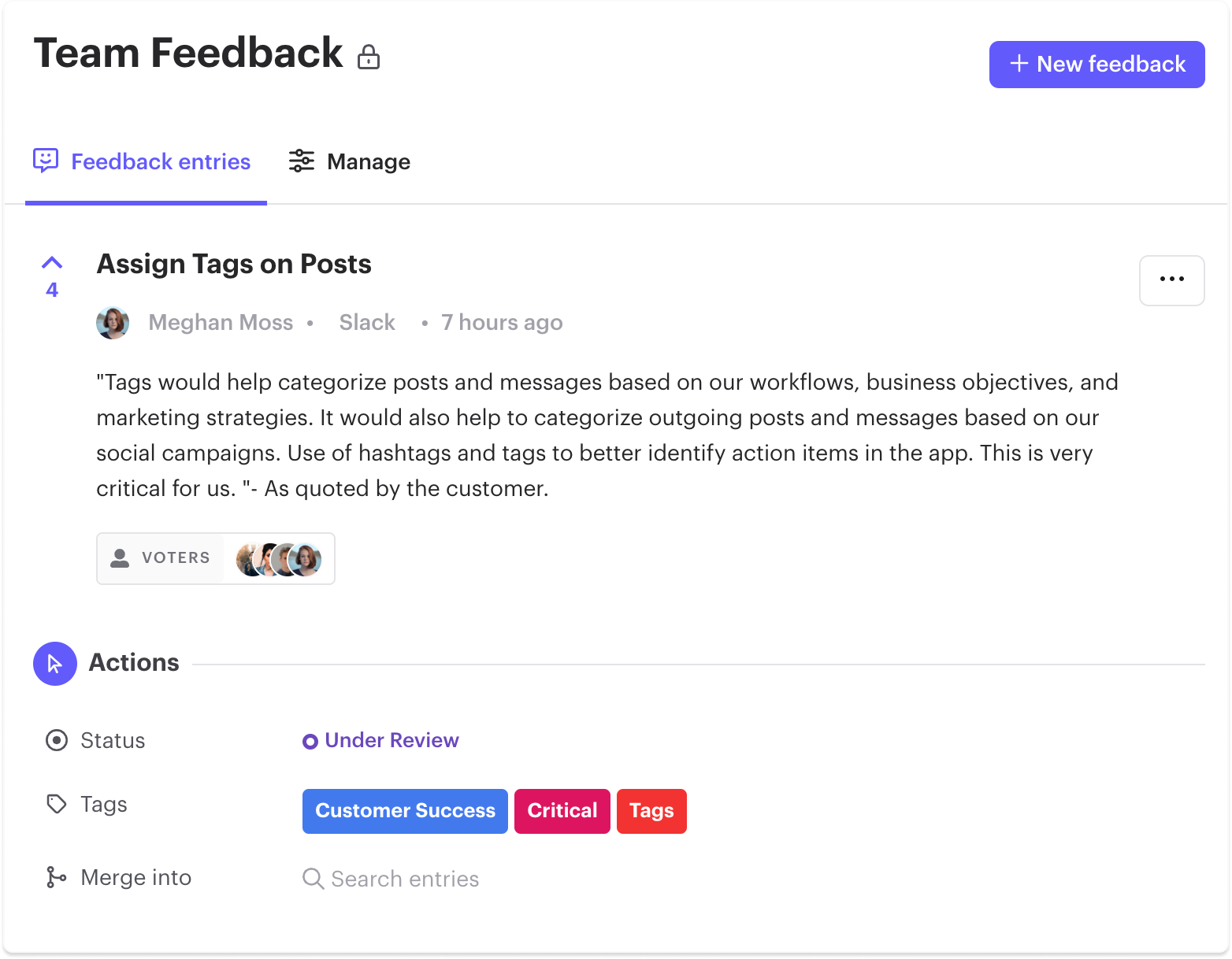
7. Social Media Monitoring
Use social media platforms to listen to what users say about your product in real-time. Social listening tools can monitor mentions, hashtags, or direct feedback.
8. Heatmaps and Session Recordings
Use heatmaps and session recording tools to observe how users interact with your product in real-time. These tools can help identify areas where users may encounter issues or confusion.
Leveraging tools like Rapidr to gather and manage real-time user feedback allows your SaaS to evolve continually based on user-driven data. This makes delighting and keeping your users engaged with your product more accessible.
Real-time SaaS Customer Feedback Examples
Real-time customer feedback is crucial for many SaaS companies, as it allows them to gauge user reactions to their software and services immediately. Here are three examples of SaaS companies that utilize real-time customer feedback mechanisms:
1. Zendesk
Zendesk is a customer service platform that offers various software solutions for support, sales, and customer engagement. One of the features they provide is real-time customer feedback through live chat and satisfaction ratings. After a support interaction, customers can rate their experience, which gives Zendesk immediate insights into their support team's performance and their users' satisfaction levels.
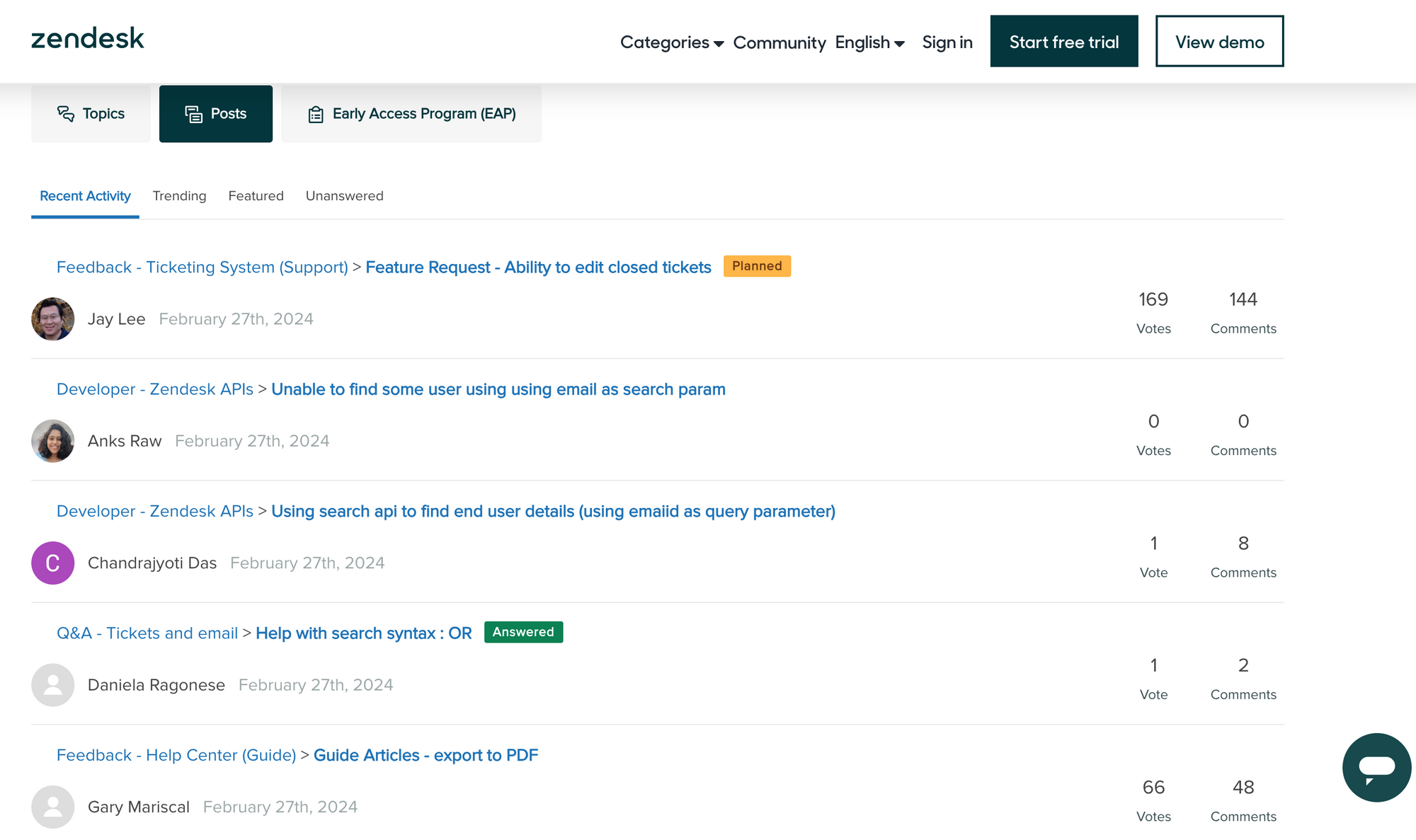
2. Intercom
Intercom is a conversational relationship platform that helps businesses build better customer relationships through personalized, messenger-based experiences. It features real-time customer feedback tools such as in-app surveys and Net Promoter Score (NPS) surveys that pop up while users engage with the application. This allows Intercom to collect feedback at the moment of interaction, making it more relevant and actionable.
3. Netflix
Netflix uses customer feedback surveys to improve its content curation, recommendation algorithms, and app interface. Netflix also gathers user feedback through NPS, CSAT, and CES surveys. Surveys help determine information about users and non-users, how users obtain and stream their video content, and if they are willing to pay more monthly for a larger amount of online streaming content with various customer feedback questions.
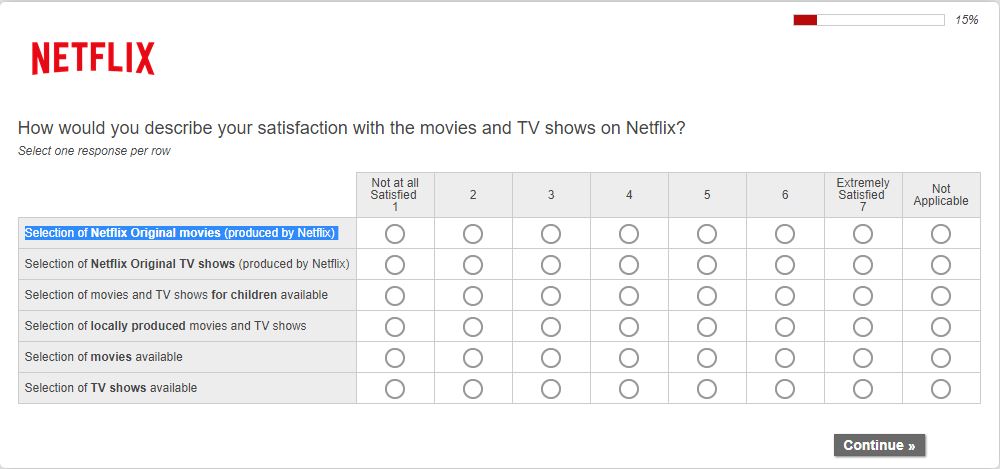
4. HubSpot
HubSpot is a comprehensive inbound marketing, sales, and service software platform. It includes features for real-time customer feedback, such as customer satisfaction surveys, customer effort score surveys, and NPS. These tools are integrated within the HubSpot platform and can trigger based on specific customer actions or milestones, providing immediate insights into the customer experience and areas for improvement.
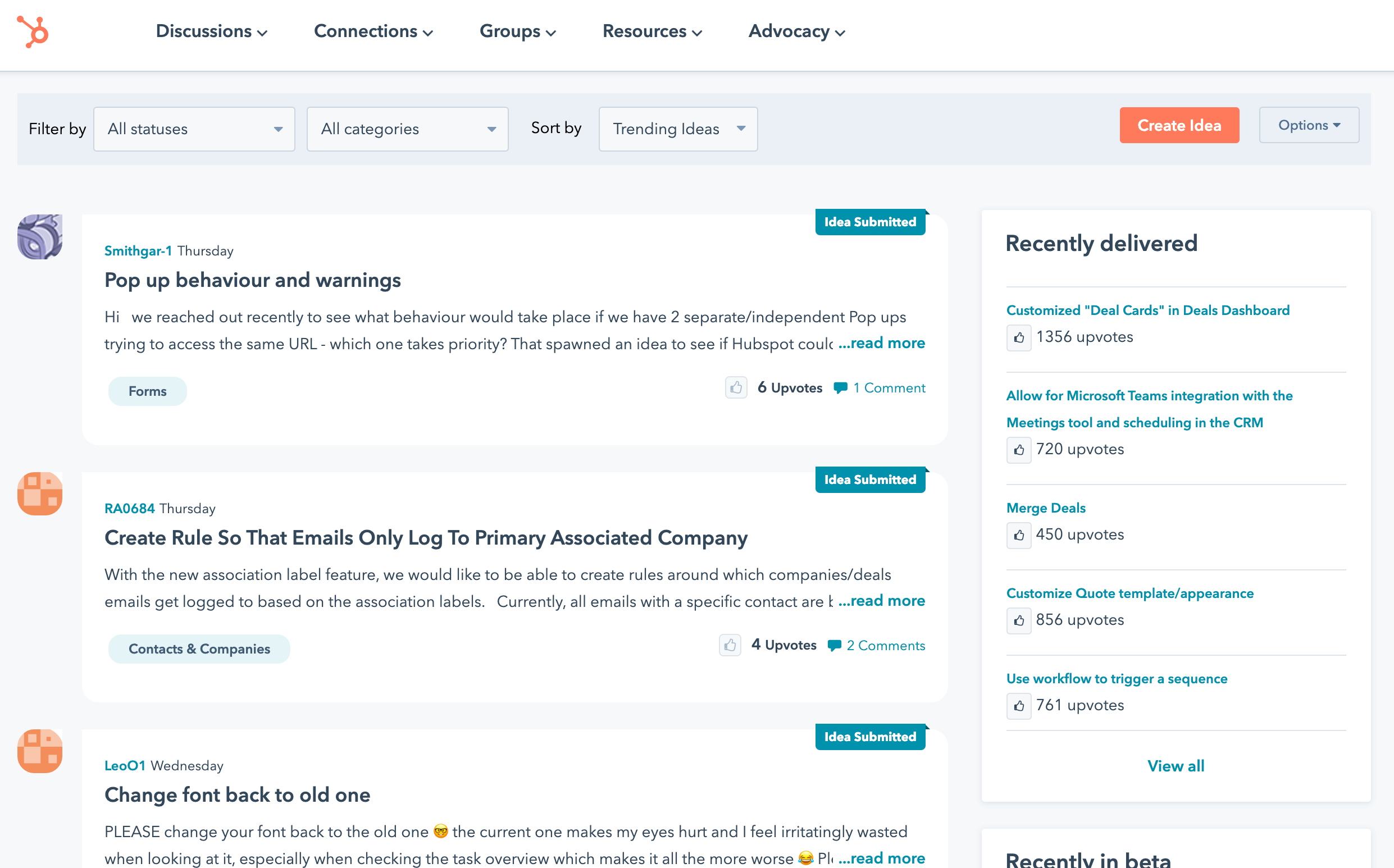
These companies use real-time feedback to continuously improve their products and services, ensuring they meet and exceed customer expectations. By leveraging such immediate insights, they can quickly adjust their offerings, resolve issues faster, and foster better customer relationships.
Tips for Collecting Real-Time Customer Feedback
Collecting real-time customer feedback is essential for businesses looking to improve their products, services, and customer experiences. Here are some best practices for collecting real-time customer feedback effectively:
- Strategically Place Feedback Mechanisms: Position feedback management systems at critical touchpoints where customers are most likely to have meaningful insights to share. This could be after a transaction, product use, or customer service interaction.
- Use a Variety of Tools: Employ different feedback collection tools such as live chat, in-app notifications, pop-up surveys, feedback buttons, and social media monitoring to capture feedback across various channels.
- Provide Multiple Channels: Give customers the option to provide feedback through the channel of their choice, whether it's via email, social media, phone, or directly within your app or website.
- Incentivize Feedback: Encourage more customers to provide feedback by offering incentives such as discounts, freebies, or entries into a contest. Make sure the incentive is relevant and valuable to your audience.
- Act on Feedback Promptly: Show customers that their feedback is valuable by acting on it quickly. Make necessary changes, address concerns, and tell customers what actions have been taken due to their feedback.
- Close the Feedback Loop: Follow up with customers who have provided feedback to let them know how their input has been used. This not only validates their effort but also encourages future engagement.
- Analyze Feedback for Insights: Use segments, feedback statuses, and votes to aggregate and analyze feedback data. Look for trends and patterns that can inform business decisions and help prioritize areas that drive product development
- Train Your Team: Ensure your customer-facing team members are trained to encourage feedback and can handle it appropriately when it comes in. They should be able to address negative feedback constructively and escalate issues when necessary.
- Ensure Privacy and Transparency: Be transparent about how you will use customer feedback and comply with data protection regulations. Customers should feel safe providing feedback, knowing their information is secure.
- Integrate Feedback with Other Data: Combine customer feedback with other data sources, such as usage statistics or purchase history, to gain a more comprehensive view of the customer experience.
- Test and Iterate: Regularly review and refine your feedback collection processes. Test different questions, formats, and timing to see what yields the most helpful feedback.
By following these best practices, businesses can gather valuable real-time insights to improve customer satisfaction, product enhancements, and a stronger competitive position in the market.
Set up a Real-Time Customer Feedback System With Rapidr
Embarking on establishing a real-time customer feedback system is a thrilling move for your SaaS business! This quick-start guide empowers you to capture actionable insights with ease.
1. Identify Key Touchpoints: Your first step is identifying the moments that matter most to your customers. Utilize every customer touchpoint, ensuring you capture feedback from as many sources as possible. Streamline your focus to where feedback will be most beneficial, such as after a service interaction or product use.
2. Choose the Right Tools: Equip yourself with a tool that fits your SaaS needs to collect customer insights and feedback effectively.
3. Gather Customer Feedback: Gather real-time customer feedback to identify opportunities to expand product reach and increase business market share.
4. Centralized and organized by category: Organize all feedback in a central location. You’ll likely receive feedback from various channels and integrations like emails, Slack channels, support inboxes, forms, and in-app widgets.
5. Easily accessible to everyone: Centralizing all feedback data in one place, which can be easily accessed, will ensure that critical feedback doesn’t get lost and will allow you to understand what to prioritize.
6. Shared across internal teams: A central hub lets customer-facing teams access and submit feedback easily. A dedicated system will also help plan regular meetups with teams to discuss customer feedback and determine how to use it to define product strategy.
7. Prioritize and analyze feedback: Prioritize product features based on user segments to make feedback-driven decisions. Remember, it's not just about collecting feedback. The real power lies in analyzing this qualitative data and implementing actionable changes that genuinely reflect your customers' desires and pain points.
8. Automate the Feedback Loop: Keep users informed about which requests are in progress or planned and which are done with a public roadmap. Respond promptly and take feedback seriously, even if it is negative. Boost customer engagement and product adoption by informing them about new releases and updates with product changelog.
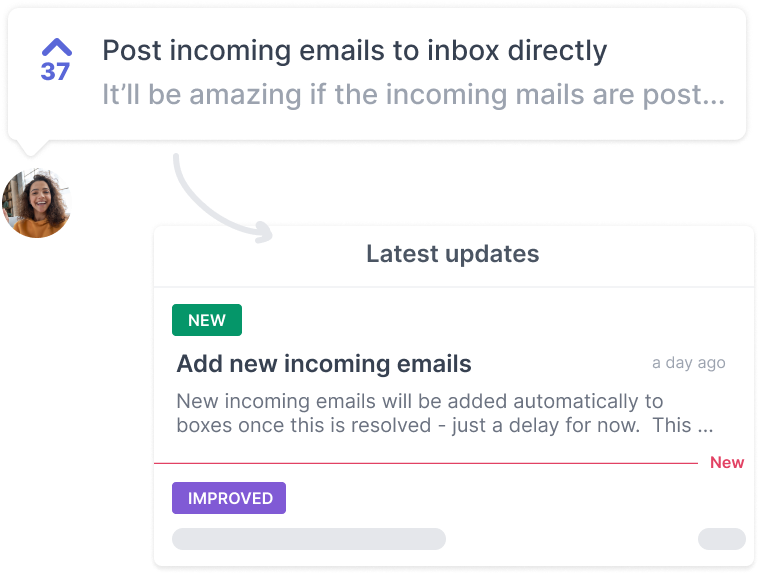
Feel the pulse of your customer base in real time and adjust swiftly to meet their needs. With a robust real-time feedback system, you're gearing up for a stronger SaaS that delights and retains customers. Incorporate real-time customer feedback into your SaaS product development.
- Set up a Customer Feedback System
- Collect Actionable Feedback from Customers and Teammates
- Analyze, Prioritize, and Categorize Feedback Data to Make Sense of It
- Act and Have a Specific Product Evolution Plan
- Announce New Features and Product Updates
With Rapidr, you can collect, analyze, and organize feedback and engage with customers as their feedback moves through the development process. Sign up for free and set up a complete customer feedback system to inform and enhance your SaaS customer journey.

